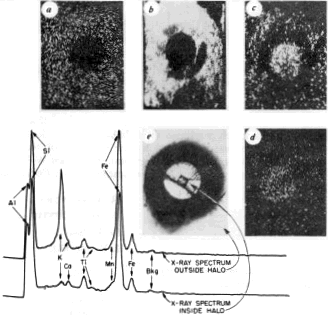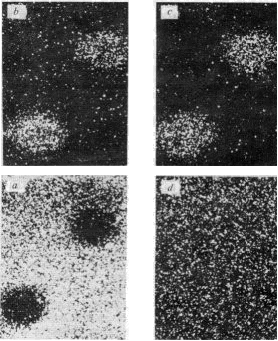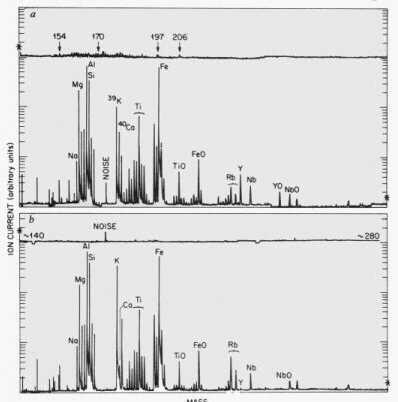|
Earth Science Associates |
||||||||||||||||||||
|
|||||||||||||||||||||
|
Giant & Dwarf Haloes |
|||||||||||||||||||||
|
|
Nature, vol. 274, no. 5670, pp. 457-459, August 3, 1978.GIANT haloes1-3 attracted little attention until it seemed that those from Madagascar2 might be associated with superheavy elements4. Even though this association was not confirmed5, this renewed interest has generated several additional suggestions6 for giant-halo origin which will be evaluated elsewhere (R.V.G. et. al. in preparation). We report here some new data on the giant haloes found in certain Swedish biotites1,2 and the implications which these data furnish for a radioactive origin of the enigmatic dwarf haloes.The majority of U and Th haloes in this Swedish biotite1,2 exhibit darkening which extends to the maximum halo radius (~38−40 μm for the Th halo). About 1% of haloes, however, have an inner bleached region which varies from ~2 to 25 μm in radius surrounding a highly radioactive inclusion. Generally, when the bleached region is small (≤6−8 μm), no change is evident in the dimensions of the halo. However, in those haloes in which the bleached region is more intense and of larger radius (~15 μm), a somewhat weakly coloured diffuse ring is generally observed outside the normal U−Th halo boundary.
Even though these giant haloes were found in Swedish granites obtained from the same location as the specimens Wiman1 used, the giant haloes described here are different from those he reported. Our giant haloes surround U and/or Th rich inclusions and have diffuse boundaries which may vary from ~42 to ~55 μm in radius. In contrast, Wiman reported giant haloes in biotite around zircon inclusions showing normal size inner rings and somewhat weak but rather sharply defined outer rings of 57 μm and more rarely of 67 μm. To show the unusual characteristics of the giant halo we found in Swedish granitic biotites from Arnö and Rickaby, we give in Fig. 1 the combined results of applying optical microscopic, electron microprobe X-ray fluorescence and ion microprobe mass spectrometer techniques. In particular, Fig. 1 shows: a transmitted light optical photomicrograph of a single giant halo of radius ~47 μm; two secondary ion maps obtained (with the ion microprobe mass spectrometer) by rastering the halo region with a finely focused 16O− beam and collecting the sputtered secondary ion signal at mass-to-charge ratios of 39 (39K) and 40 (40Ca); two X-ray maps obtained (using electron microprobe X-ray fluorescence) by rastering the same region with a 30-kV electron beam and collecting in sequence the K Kα and Ca Kα X rays; and the complete electron microprobe X-ray fluorescence spectra obtained by spot focusing the electron microprobe beam first on the mica completely outside the giant halo and then on the bright circular area inside it. In Fig. 1, the secondary ion and X-ray maps, as well as the contrasting X-ray spectra, show the region corresponding to the bright circular area in the optical photo (which differs slightly in magnification from the maps) is considerably diminished in K (by about a factor of 10) and slightly enhanced in Ca compared to the surrounding mica. Also, the secondary ion and X-ray maps in Fig. 1 reflect the composition of the halo region several micrometres above the central radioactive inclusion, the rectangular outline of which can be seen in the optical photo in Fig. 1. Certain mineralogical aspects relating to this phenomenon have been reported previously by Rimsaite9. These giant haloes probably did not result from diffusion of radioactivity into the mica because ion microprobe mass spectrometer studies showed U, Th and Pb were confined to the inclusion.
As far as the formation of GH is concerned, the large K depletion in the central region may have been accompanied by depletion of other major elements during past epochs. If this happened, then for a certain period of time the total mass within this region may have reduced sufficiently to allow the highest normal energy αs of the Th and U series (8.73 MeV and 7.68 MeV respectively) to penetrate beyond the normal halo boundary because of having first passed through a region of lower density. Because of the large K depletion and slight Ca enrichment, this region has a slightly lower density than the adjacent mica. But unless O, which we have not as yet measured, is also depleted, the K (comprising only ~5−10 atomic % of the biotite) depletion alone would not be sufficient to permit normal energy αs to gain enhanced penetration of ~15 μm. Although there are unanswered questions about this phenomenon it seems that the bleached areas are high radiation damaged regions. This was very important to our studies of the dwarf haloes10,11, the exact origin of which has remained a mystery for more than 50 years. Under the microscope, the dwarf haloes11 exhibit the same type of bleached appearance as is shown by the giant haloes in Fig. 1. Furthermore, in analyzing the dwarf halo centres for the presence of some recognizable parent and/or daughter radionuclides, it became evident that the same type of K−Ca inversion phenomenon was showing up throughout the dwarf halo region. Figure 2a−d shows several secondary ion maps obtained as an 16O− beam was rastered across two closely spaced dwarf haloes. The ion microprobe mass spectrometry ion maps in Fig. 2a−d reveal that these dwarf haloes were highly depleted in 39K and enriched in 40Ca and 89Y with no change in 28Si. The complete mass scans shown in Fig. 3a, b, contrasting the dwarf halo region (Fig. 3a) with the surrounding mica (Fig. 3b), reveal a corresponding depletion of 41K, 85Rb, and 87Rb. Scanning electron microscopy X-ray fluorescence maps of many dwarf haloes also showed the depletion of K and enrichment of Ca throughout the dwarf halo, showing that the ion microprobe mass spectrometer results were not an artifact of the sputtering process. We consider the association of this K−Ca inversion phenomena with the dwarf haloes as additional evidence of a radioactive origin of the dwarf haloes.
(Fig. 3b). Even though Fig. 3b does not show any rare earths in the mica, other ion microprobe mass spectrometry and spark source mass studies showed that these elements do exist in the mica in very low abundance. We suggest that the mechanism for this enrichment is the same as that which caused the preferential transport of Ca (Fig. 2b) into the halo region (the ion maps of Ca and the rare earths are equal in extent). Note also the Y enrichment in the halo (Fig. 3a) compared to the mica (Fig. 3b). In conclusion, despite this new evidence for a radioactive origin of the dwarf haloes, more work is needed before the radionuclides which produced these haloes can be identified. This research was supported by the Division of Nuclear
Sciences, US Department of Energy, under contract W-
7405-eng-26 with the Union Carbide Corporation and by
Columbia Union College.
Received 13 March; accepted 17 May 1978.References
|
|
||||||||||||||||||
|
|
|||||||||||||||||||||
|
|||||||||||||||||||||
|
Earth Science Associates
|
|||||||||||||||||||||




